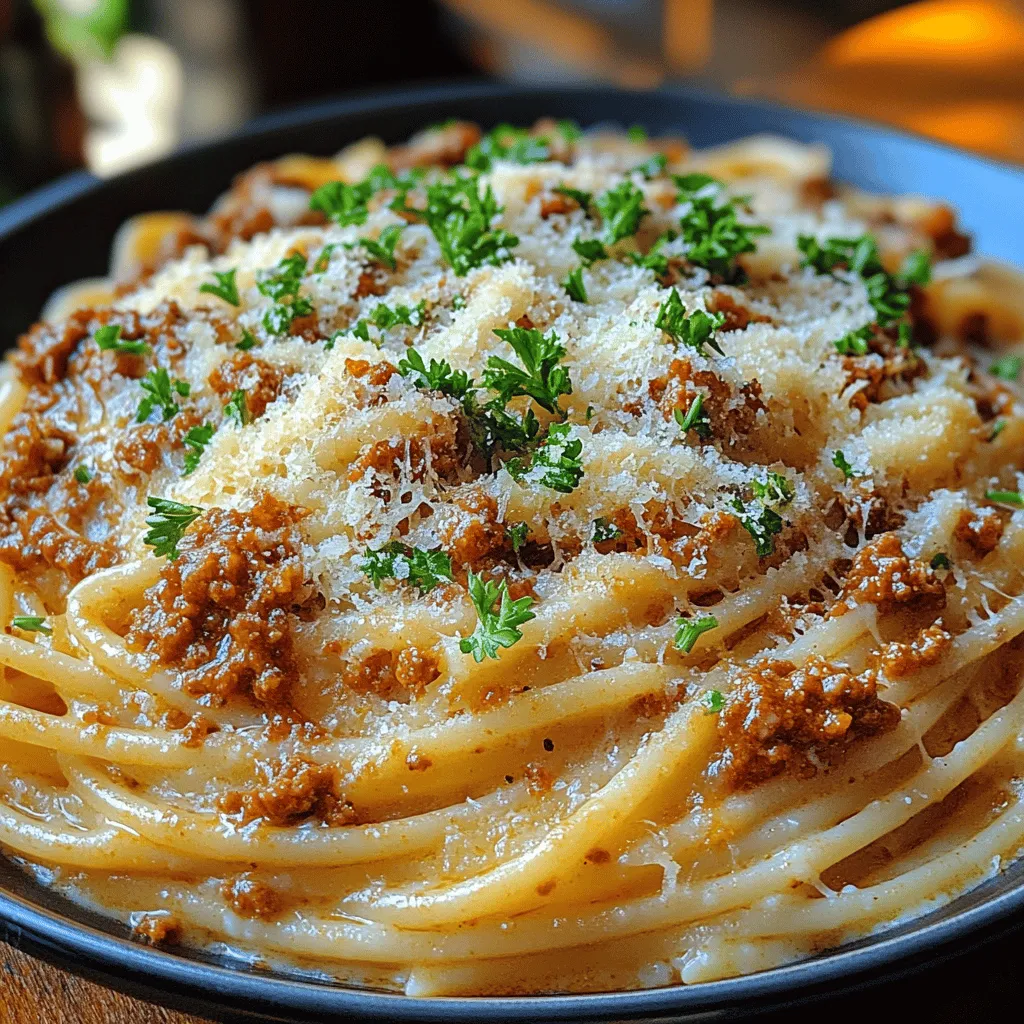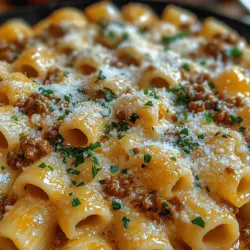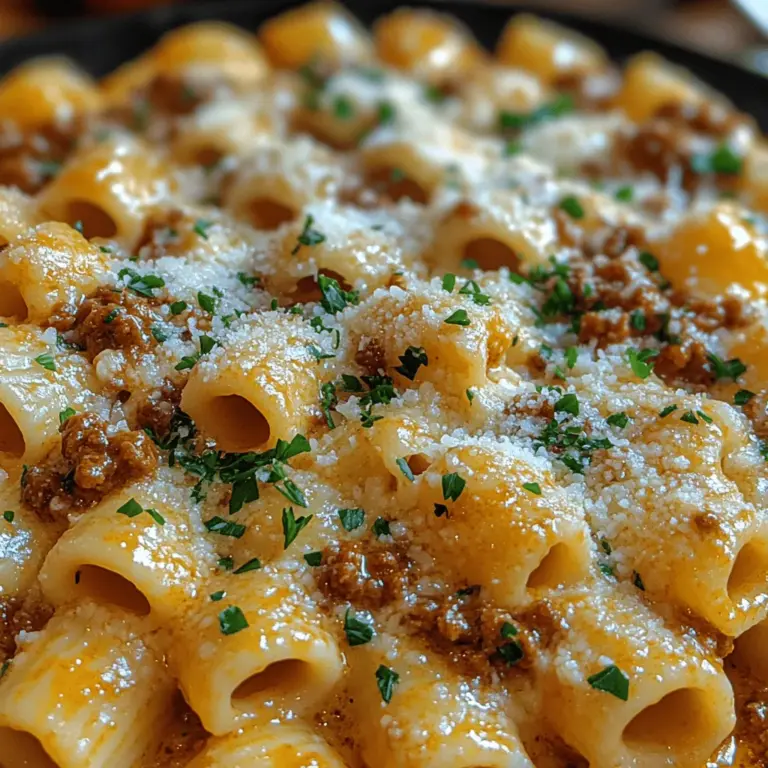Introduction
Understanding the rich tapestry of Italian cuisine is essential for food enthusiasts, and one dish that stands out is the Creamy White Bolognese Delight. This exquisite recipe presents a delightful twist on the traditional Bolognese sauce, known for its robust flavors and deep red hue. Unlike its classic counterpart, which is characterized by its tomato base, the Creamy White Bolognese introduces a luxurious texture and depth of flavor that elevates pasta to a new level of indulgence. The shift from a tomato-rich sauce to a creamy, white version not only adds a unique flavor profile but also transforms the dish into a comforting and elegant meal perfect for any occasion.
In this article, we will delve into the origins of this dish, the essential ingredients that contribute to its creamy richness, and the step-by-step instructions to create your very own Creamy White Bolognese Delight. Whether you are a seasoned cook or just starting your culinary journey, this guide will provide you with all the insights you need to master this delightful dish and impress your family and friends at your next dinner gathering.
The History of Bolognese Sauce
To truly appreciate the Creamy White Bolognese Delight, it’s important to explore the traditional roots of Bolognese sauce. Originating from the city of Bologna in northern Italy, this sauce has been a staple of Italian cuisine since the late 18th century. The traditional Bolognese, known as “ragù alla bolognese,” is a rich meat sauce that primarily features ground beef, pork, and a medley of vegetables, simmered together with red wine and tomatoes. Over the years, various regions of Italy have adopted their own variations of the sauce, each adding unique twists that highlight local ingredients and culinary customs.
The evolution from a classic meat sauce to the creamy variant we celebrate today reflects a broader trend in Italian cooking, where chefs seek to balance tradition with innovation. The inclusion of dairy—specifically milk and cream—into the sauce creates a velvety texture that contrasts beautifully with the savory elements of the meat and vegetables. This transformation not only changes the flavor profile but also demonstrates the adaptability of Italian cuisine, where tradition meets creativity.
Culturally, Bolognese sauce holds significant importance in Italian dining, often associated with family gatherings and festive occasions. It is a dish that brings people together, embodying the essence of Italian hospitality. The Creamy White Bolognese Delight, in particular, elevates this classic to new heights, making it suitable for both casual weeknight dinners and elegant dinner parties.
Ingredients Breakdown
Creating the perfect Creamy White Bolognese Delight begins with understanding the core ingredients that contribute to its unique flavor and texture. Here’s a detailed overview of what you’ll need:
Ground Meat: Choosing Between Beef and Veal
The foundation of any Bolognese sauce is the meat, and for the Creamy White Bolognese, you have a choice between ground beef and veal. Beef offers a robust flavor and is often preferred for its hearty texture. On the other hand, veal provides a more delicate and slightly sweet taste, which can enhance the creaminess of the sauce. You can even opt for a combination of both for a richer flavor profile.
Vegetables: The Aromatic Blend of Onion, Garlic, Carrot, and Celery
A classic mirepoix—comprising onion, garlic, carrot, and celery—forms the aromatic base of the sauce. These vegetables not only add depth and sweetness but also contribute essential nutrients. When chopped finely, they blend seamlessly into the sauce, creating a harmonious flavor without overwhelming the palate. Sautéing these vegetables until they are soft and fragrant is crucial for developing the sauce’s flavor.
Mushrooms: Enhancing Texture and Flavor
Mushrooms are an essential addition to the Creamy White Bolognese, providing a unique umami flavor that complements the meat. Varieties such as cremini or shiitake work particularly well, as they add both earthiness and a satisfying texture to the sauce. The mushrooms should be finely chopped or sliced to ensure they integrate well into the sauce.
Dairy: The Role of Milk and Cream in Creating Richness
Dairy is what sets this Bolognese apart from the traditional version. The addition of milk and cream not only creates a silky texture but also helps to mellow the flavors, allowing the sauce to achieve a rich, comforting quality. Whole milk is typically added early in the cooking process to tenderize the meat, while heavy cream is incorporated towards the end to enhance the sauce’s luxuriousness.
Herbs and Spices: Balancing Flavors with Oregano and Thyme
Herbs and spices play a vital role in flavoring the Creamy White Bolognese. Fresh oregano and thyme are excellent choices, as they impart a fragrant aroma that complements the richness of the sauce. Dried herbs can also be used if fresh ones are unavailable; however, fresh herbs tend to provide a brighter flavor.
Wine: The Importance of Dry White Wine in Deglazing and Flavor Enhancement
White wine is a crucial ingredient in this recipe, as it not only adds acidity but also helps deglaze the pan, lifting any flavorful bits stuck to the bottom. A dry white wine, such as Sauvignon Blanc or Pinot Grigio, works best to enhance the overall flavor without overpowering the dish. The alcohol content will cook off during the simmering process, leaving behind a subtle complexity that elevates the sauce.
Final Touches: Garnishes and Cheese for Presentation
To finish your Creamy White Bolognese Delight, consider garnishing with freshly grated Parmesan cheese and a sprinkle of freshly chopped parsley. Not only do these toppings add visual appeal, but they also contribute additional layers of flavor that tie the dish together beautifully.
Step-by-Step Cooking Instructions
Now that we have a clear understanding of the ingredients, it’s time to dive into the cooking process. This section will guide you through the initial steps of creating your Creamy White Bolognese Delight, ensuring that you achieve the best results.
Sautéing the Base
1. Preparation of Ingredients: Begin by preparing your vegetables. Finely chop one medium onion, two cloves of garlic, one medium carrot, and one stalk of celery. The key to achieving optimal flavor development is to ensure that all vegetables are cut to a uniform size, allowing them to cook evenly.
2. Heating the Pan: In a large, heavy-bottomed skillet or Dutch oven, heat two tablespoons of olive oil over medium heat. You want the oil to shimmer but not smoke, indicating that it is hot enough for sautéing.
3. Sautéing the Vegetables: Add the chopped onions, carrots, and celery to the pan. Sauté these vegetables for about 5-7 minutes, stirring occasionally, until they become soft and translucent. This process helps to release their natural sugars, creating a sweet base for your sauce. Add the minced garlic in the last minute of cooking to prevent it from burning and becoming bitter.
4. Understanding Vegetable Sizes and Cooking Times: It’s essential to chop your vegetables finely, as larger pieces will take longer to cook and may not meld well into the sauce. The goal is to achieve a soft, aromatic base that will serve as the foundation for the rest of the ingredients.
Browning the Meat
1. Adding the Ground Meat: Once the vegetables are perfectly sautéed, increase the heat to medium-high and add one pound of your chosen ground meat—beef, veal, or a mix of both.
2. Browning Techniques: Use a wooden spoon to break the meat apart as it cooks. Allow it to brown evenly, which should take about 8-10 minutes. It’s important not to overcrowd the pan, as this can cause the meat to steam rather than brown. If necessary, brown the meat in batches to achieve that ideal caramelization.
3. Draining Excess Fat: Once the meat is nicely browned, you may notice some excess fat in the pan. To drain it without losing flavor, carefully tilt the pan and use a spoon to remove the fat while leaving the flavorful browned bits intact. This step ensures that your Creamy White Bolognese Delight remains rich without becoming greasy.
4. Deglazing the Pan: With the meat browned and excess fat removed, it’s time to deglaze the pan. Pour in half a cup of dry white wine, scraping the bottom of the pan with your wooden spoon to lift any caramelized bits. This process not only enhances the flavor but also adds acidity, which balances the richness of the sauce. Allow the wine to simmer for a few minutes until it has reduced slightly.
Following these initial steps will set a solid foundation for your Creamy White Bolognese Delight. As we continue, we will delve deeper into the remaining steps of this culinary creation, transforming simple ingredients into a dish that embodies the essence of Italian comfort food. Stay tuned for the next part, where we will explore the finishing touches that will elevate your sauce to perfection.

Adding Mushrooms
Incorporating mushrooms into your Creamy White Bolognese Delight is not just about adding texture; it’s about enhancing the dish’s umami flavor profile. As you prepare your sauce, the timing of when to add the mushrooms is crucial for maximizing their flavor and texture.
Start by selecting mushrooms that complement the creaminess of the sauce; cremini or shiitake mushrooms are excellent choices due to their rich, earthy flavors. Chop them into uniform pieces to ensure even cooking.
Time Management for Incorporating Mushrooms Effectively
When you reach the point of sautéing your aromatics (onions, garlic, and carrots), add the mushrooms immediately after the onions become translucent. This allows the mushrooms to cook down properly, releasing their moisture and flavor into the sauce. Sauté them until they are golden brown and tender, which typically takes about 5-7 minutes. This step not only infuses the sauce with a deeper flavor but also enhances the overall texture of the dish.
The Role of Mushrooms in Enhancing Umami Flavor
Mushrooms are known for their ability to enhance umami, which is the savory flavor that rounds out the dish. When cooked, they release glutamate, a naturally occurring substance that intensifies the taste experience. This depth of flavor is essential in a white Bolognese sauce, providing a savory counterpoint to the creaminess of the dairy ingredients. As the mushrooms meld with the meat and other vegetables, they create a complex and satisfying flavor profile that elevates your pasta dish.
Deglazing with Wine
After the mushrooms have sautéed and are ready to incorporate their flavors, the next step is to deglaze the pan. This is an essential technique that enhances the depth of your sauce.
The Significance of Deglazing and Scraping Up Fond
Deglazing involves adding a liquid to the hot pan to loosen the flavorful bits (fond) stuck to the bottom. This step is crucial as it brings all those concentrated flavors back into the sauce, ensuring that no taste goes to waste. To deglaze, pour in your choice of wine while scraping the bottom of the pan with a wooden spoon. The steam will help lift the fond, creating a rich base for your sauce.
Discussing the Choice of Wine and Its Impact on Flavor
The choice of wine can significantly impact the final flavor of your Creamy White Bolognese. A dry white wine, such as Pinot Grigio or Sauvignon Blanc, is ideal as it complements the creamy elements without overpowering them. If you prefer a subtle sweetness, consider a Chardonnay, but avoid overly sweet wines. The acidity in the wine will balance the richness of the cream and meat, adding a refreshing contrast that enhances the overall dish.
Incorporating Dairy
After deglazing, it’s time to add the creamy components that will make this Bolognese truly indulgent.
The Correct Order and Timing for Adding Milk and Cream
Begin with adding whole milk first. This allows the milk to blend smoothly into the sauce without curdling. Pour it in gradually, stirring continuously to incorporate it fully. After the milk has been absorbed and the sauce has thickened slightly, it’s time to add the heavy cream. This addition is what gives the white Bolognese its luxurious texture.
Monitoring the Simmering Process for Desired Consistency
Once the dairy ingredients are in, reduce the heat to a low simmer. It’s important to keep an eye on the sauce as it simmers, stirring occasionally. The goal is to achieve a creamy consistency without allowing it to boil, which could cause the cream to separate. After about 10-15 minutes of simmering, the sauce should be rich and velvety, coating the back of a spoon.
Adjusting Seasoning
The final touch to your Creamy White Bolognese Delight is adjusting the seasoning to ensure a perfectly balanced flavor.
Guidance on Tasting and Adjusting Flavors
As you near the end of your cooking process, take a moment to taste the sauce. This is your opportunity to balance the flavors. If it feels a bit flat, consider adding a pinch of salt, which enhances the overall taste. Freshly cracked black pepper is also a great addition, offering a subtle heat that complements the creaminess.
Alternatives for Achieving the Right Balance, if Necessary
If you find the sauce too rich, a squeeze of fresh lemon juice can brighten it up and cut through the creaminess. Alternatively, a sprinkle of freshly grated nutmeg can add warmth and depth. Remember, the key to a great sauce is to taste as you go, ensuring the flavors develop harmoniously.
Serving Suggestions
Now that your Creamy White Bolognese Delight is ready, it’s time to consider how best to serve it.
Recommended Pasta Pairings for the White Bolognese Sauce
Traditionally, this sauce pairs beautifully with wide pasta shapes that can hold onto the creamy sauce. Fettuccine, pappardelle, or tagliatelle are excellent choices. Cook your pasta al dente, as it will continue to soften when mixed with the sauce. Toss the cooked pasta with the sauce in a large pan to combine thoroughly, allowing the pasta to absorb the flavors.
Presentation Tips for an Appealing Dish
To elevate the presentation of your dish, consider garnishing it with fresh herbs such as parsley or basil. A sprinkle of freshly grated Parmesan cheese adds a savory finish and a touch of elegance. For added color, a few slices of roasted cherry tomatoes can provide a vibrant contrast. Serve the dish in warm bowls or plates to keep it hot, and enjoy the visual appeal of your culinary masterpiece.
Nutritional Benefits of the Ingredients
One of the many advantages of this Creamy White Bolognese Delight is its nutritional value, making it not only delicious but also satisfying.
Protein Content from Meat and Dairy
The primary ingredients in this recipe, including ground meat and dairy, contribute a significant amount of protein. Protein is essential for muscle repair and growth, making this dish a wholesome choice for those looking to maintain a balanced diet.
Vitamins and Minerals from Vegetables
The addition of carrots and onions not only enhances the flavor but also provides essential vitamins and minerals. Carrots are rich in beta-carotene, which is important for eye health, while onions offer antioxidants that support overall health.
The Impact of Portion Control on Overall Health
While this dish is rich and flavorful, portion control is key to maintaining a healthy diet. Enjoying a well-sized serving alongside a fresh salad or steamed vegetables can help balance out the meal, ensuring you reap the nutritional benefits without overindulgence.
Conclusion
The Creamy White Bolognese Delight is more than just a meal; it’s an experience that brings the warmth of Italian tradition to your dining table. With its rich flavors and creamy texture, this dish is sure to become a favorite among family and friends. By following this comprehensive guide, you can create a restaurant-quality dish right at home, allowing you to impress your guests and satisfy your culinary cravings. Embrace the art of cooking and enjoy the delightful process of preparing this creamy masterpiece. Whether it’s a weeknight dinner or a special occasion, this white Bolognese will undoubtedly leave a lasting impression.


